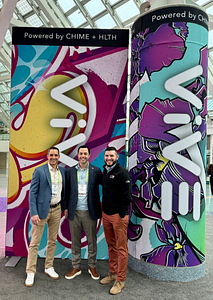In the transition to a new value-based, patient-centric healthcare model, hospitals and healthcare systems face several challenges. They’re expected to enable their staff to work more efficiently, reduce labor and operating costs, and comply with changing regulations – all while delivering optimal patient care experiences. Additionally, challenges from COVID-19 have caused healthcare labor shortages as high as 30% in certain areas, further heightening the ability to deliver high-quality care.
Healthcare technology becomes key to delivering patient-centric care. Technology-enabled smart hospitals, for example, provide a model for connected insights and experiences. According to Frost and Sullivan, smart hospitals “are those that optimize, redesign, or build new clinical processes, management systems, and potentially even infrastructure, enabled by underlying digitized networking infrastructure of interconnected assets, to provide a valuable service or insight which was not possible or available earlier, to achieve better patient care, experience and operational efficiency.”
In other words, a smart hospital is a hospital that becomes a platform of interconnected digital healthcare components, which can provide deep insights into operational, clinical, and patient activities at the touch of a button, ultimately delivering a more connected patient experience.
As hospitals and healthcare systems journey towards becoming smart facilities, a key component of their “smart” strategy will be the adoption of healthcare technology platforms that enable digital asset tracking and management, like Real-Time Location Services (RTLS). After all, such solutions are a “smart” investment.
Why invest in RTLS Healthcare Technology?
RTLS is a digital healthcare innovation that uses a system of sensors, platforms (e.g., low energy, low frequency), hardware, and software to provide immediate or real-time tracking and management of medical equipment, staff, and patients throughout patient care environments.
Think of RTLS as the Uber of hospital services. Just as this personal transportation company provides the right car to the right person at the right place, RTLS solutions help locate the right equipment, right staff, and/or right patient using different healthcare applications, such as EHRs, nurse call systems, and security systems.
Because it reduces hours spent searching for key assets and people, RTLS healthcare technology allows clinicians to focus on patient care while minimizing patient wait times. Moreover, data collected from RTLS solutions can help hospitals and healthcare systems pinpoint staffing inefficiencies and operational bottlenecks, thus improving patient throughput and satisfaction, and increasing the bottom line.
Given the number of successful use cases, it should come as no surprise the RTLS market is expected to reach $12.7 billion by 2026.
What are these use cases and how can they improve the patient experience at your facility? Let’s take a look.
RTLS Use Cases Highlight Healthcare Innovation at its best
Adoption of RTLS healthcare technology can provide you with demonstrable return on your investment in three key areas – operational, clinical, and patient activities.
RTLS Capabilities | Benefits | Use Case | |
Operations | Allows nursing & frontline medical staff to track and monitor hospital assets, including scanners, monitors, & wheelchairs |
| Texas Health saved $412K during its first year of RTLS deployment, as medical equipment can now be easily located & maintained |
Clinical | Tracks patient flow through a hospital, from arrival to admission to discharge to bed turn |
| Adventist Health White Memorial saved $1M per year by overhauling operating room processes |
Patient Centricity Wayfinding for Patients & Visitors | Provides simple turn-by-turn directions which make it simple to navigate complex hospital campuses |
| Wake Forest Baptist delivered more than $10M in estimated benefits by creating the “ultimate patient experience” |
Use cases for RTLS healthcare technology, however, are not limited to these applications. In fact, the COVID-19 pandemic has only increased interest in RTLS, specifically in relation to infection control measures. That’s because RTLS can power contact tracing within hospitals, monitor temperatures, air pressure, and other environmental conditions, and help improve rates of hand-hygiene compliance.
How Healthcare Ecosystems Can Help Implement RTLS
As many of the top smart hospitals in the U.S. can attest, adopting smart hospital technology solutions is a journey, not a destination. And on that journey, you should consider collaborating with healthcare innovation ecosystem partners to identify, source, and pilot RTLS and other smart healthcare technology. Healthcare ecosystems, like 11TEN Innovation Partners, work closely with operational and clinical health system leaders to provide the innovation horsepower and infrastructure needed to:
- Source leading digital technology companies and solutions that meet your hospital’s specific needs
- De-risk smart hospital innovation investments through targeted pilots
- Manage pilot projects from end-to-end in conjunction with hospital stakeholders
- Validate healthcare technology solutions and deliver key insights on performance and scaling
Together with other ecosystem partners, 11TEN can take your “smart” strategy to the next level: helping you go further, innovate faster, and focus on what’s most important – the patient.
Visit our Innovation Lab and contact us today to learn more.


